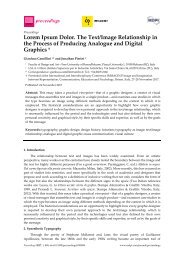proceedings-01-00898
You also want an ePaper? Increase the reach of your titles
YUMPU automatically turns print PDFs into web optimized ePapers that Google loves.
Proceedings 2<strong>01</strong>7, 1, 898 6 of 10<br />
composed using a keyboard similar to those of modern-day computers and then impressed on<br />
photographic film (Machines like the Fotomaster, introduced in the late 60s, made it possible to<br />
directly apply a series of deformations and distortions of the character, effects and filters, produced<br />
via a photographic process, during the composition process). The matrixes of characters are physical<br />
and produced on film. The characters and images are therefore produced from the same substance:<br />
both impressed on film, they can undergo similar treatments and transformations. The restrictive<br />
heaviness and rigidity of the composition materials that the avant-gardes, typographers and futurist<br />
printers had to contend with, as well as the aforementioned Weingart many years later, really<br />
appears to be a thing of the past. We are therefore closer to the electro-library prophetically<br />
announced by El Lissitzky in his 1923 manifesto Topography of Typography [8]. The synthetic and<br />
analytical possibilities created by the activation of the non-linear space is the biggest novelty of<br />
phototypesetting. With the break between the text and the image having been done away with, the<br />
linearity of the text can now be questioned more radically. But that’s not all, it is the essence of the<br />
text itself that represents the antithesis of the idea that the image is in danger: the text is the image.<br />
There is no need for theoretical discourses or practical experimentation to prove it. The evidence is<br />
the very substance from which the text and image are produced. Yet it is not necessarily the triumph<br />
of the expressive and synesthetic use of the text. The same phototypesetting procedure can be used<br />
to create graphics in which the text fully exploits and experiments with the plastic possibilities of<br />
design—Grignani’s graphics produced for Alfieri & Lacroix in the late 50s and early 60s, for<br />
example—or to produce layouts in which text and images are clearly distinct, not physically relating<br />
with each other. This can be seen in the posters created by Massimo Dolcini for the Municipality of<br />
Pesaro between 1971 and the mid-1980s. In his work, while the text is used to clearly and directly<br />
communicate an unequivocal message, the image is designed to convey information that can be<br />
interpreted in different ways, that is more evocative and less rational [9]. While Dolcini’s images are<br />
always the result of a plastic and often iconic transformation, beginning with images found and<br />
taken from daily life and from the work of designers and artists in which he intervenes, the original<br />
design of the text remains untouched. One exception is one of his first manifestos, designed to<br />
encourage the public not to waste water because it is a public resource. Here, the headline, inserted<br />
in the form of a bottle, is rippled by means of a photographic transformation similar to many of those<br />
he carried out using a camera obscura when he was a student at ISIA in Urbino (The photographic<br />
experimentation carried out by Dolcini during the Photographic Techniques course he attended at<br />
ISIA in Urbino in 1968/1969 can be found at the Graphic Design Documentation Centre of the<br />
AIAP—the Italian Association of Visual Communication Design, Milan). (Figure 4). However, in the<br />
majority of his manifestos, the design of the characters does not undergo changes. Not only are these<br />
not modified in terms of their design, their position compared with the image is also independent.<br />
The texts are often inserted in special spaces, fields or boxes which, like classic scrolls, graphically<br />
and unequivocally separate the text from the image (Figure 5). Dolcini asserts that the aesthetic of his<br />
manifestos is a consequence of the use of a precise technique and a process, the use of a small repro<br />
camera and screen printing, which characterise his simple designs with their clear strokes and<br />
vibrant colours. But the technique is nothing other than a component of the project that contributes<br />
to producing the final graphic. In Dolcini’s work, in the definition of his approach to using text and<br />
therefore in his treatment of the text/image relationship, of primary importance are his reference<br />
models—those of a modern Imagerie d’Epinal [10]—and the goals of the message, associated with a<br />
public function, addressed to a broad public and necessarily for immediate use.



